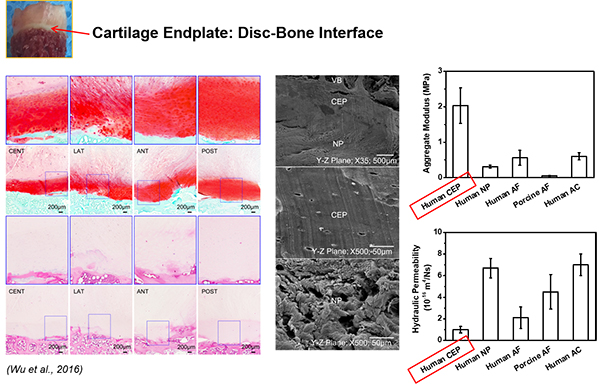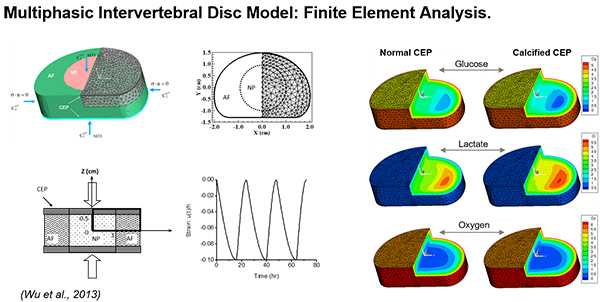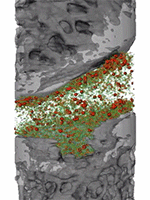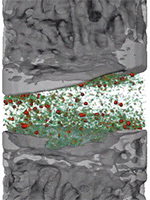Project A: Morphological, Biochemical and Biomechanical Characterization of Human Cervical Endplate in Degenerated Disc [Funded by NIH (NIAMS) and Cervical Spine Research Society (CSRS)]
The degenerative changes that occur in the cervical disc have been implicated as a possible primary etiologic factor of neck pain. The superior and inferior thin cartilage endplate (CEP) layers are the main transport pathways of the cervical disc. Pathological changes in CEPs may initiate and accelerate the progression of cervical disc degeneration with its negative effects on solute transport to the disc. Due to the unique soft tissue-bone junction structure and complexity of the mechano-electrochemical coupling phenomena in CEP tissues, there is a lack of quantitative understanding of solute transport through the human CEPs in healthy and degenerated cervical discs, as well as a lack of understanding in the corresponding biochemical properties and morphological patterns of the CEPs.
Our hypothesis is that, compared to the endplate in a healthy disc, the CEPs in an early stage degenerate disc is stiffer and less permeable to solutes while the CEPs in a middle or late stage degenerate disc is less stiff and more permeable to solutes, and that CEP calcification and ossification progression affect the solute transport by changing tissue hydration, fixed charge density, and the extracellular matrix structure. The objective is to fill the knowledge gap by characterizing the structure-function relationship of human cervical CEPs under different disc degeneration conditions.
Project B: Role of Endplate in Disc Degeneration under the Influence of Tobacco Smoke Exposure: An Animal Model in the Sprague Dawley Rat
Tobacco smoke is associated with spine-related pain. Nicotine may directly disrupt disc homeostasis by increasing local inflammatory cytokine levels, reducing the rates of cell proliferation, biosynthesis, and metabolism. Alternatively, due to vasoconstriction and decreased blood oxygen carrying capacity, smoke exposure may attenuate the nutrient supply to the disc and break the tissue homeostasis. However, the intrinsic mechanism by which tobacco smoking engenders disc degeneration remains unclear.
We hypothesize that high nicotine levels or hypoxia in the endplate region (disc-vertebral body interface) may initiate cartilage calcification. Together with smoking induced vasoconstriction and hypoxemia, endplate calcification may reduce the nutritional solute exchange through the disc-bone interface, damage the disc tissue homeostasis, and lead to disc degeneration. The objective is to investigate role of endplate in disc degeneration under the influence of tobacco smoke exposure using a rat animal model. In addition, potential recovery effects of smoke cessation and dynamic mechanical loading on the endplate and disc homeostasis will be assessed to help develop optimized rehabilitation strategies.
Our long-term goals are to 1) establish a grading system of endplate calcification and mineralization using bioimaging techniques for early diagnosis of disc degeneration; 2) develop novel, less-invasive disc functional assessment tools; 3) develop personalized treatment and rehabilitation strategies for restoring disc-bone interface function and retarding further disc degeneration.




